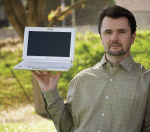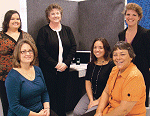THE Journal's 2008 Innovators :: 1
Jim Klein
Saugus Union School District (CA)

It didn't take too much extra effort for Saugus Union School
District in Southern California to formalize its green computing
initiative. Two essential components were already in
place: the willingness to use open source software and a
healthy inventory of older computers.
By reusing that aging inventory of machines in new ways, the
district won't have to send them to a landfill. "The numbers are
pretty significant," says Jim Klein, the director of information
services and technology for the K-6 district. Through a tool
called the Electronics Environmental Benefits Calculator,
developed by the US Environmental Protection Agency, Klein found that reusing just one computer with
a CRT monitor saves 30 pounds of hazardous waste; 77 pounds
of solid waste; 7,719 kilowatts of energy; 1,333 pounds of carbon
dioxide from being emitted into the atmosphere; and 32 tons of
air and 147 pounds of water from being polluted.
The green initiative was launched late last summer at Santa
Clarita Elementary School, where over the course of two days
Klein and his team of three deployed a lab with 32 computers,
all between six and eight years old, running as Linux terminals. They bought a bunch of Hewlett-Packard
(HP) flat-panel monitors, trying to strike a balance
between functionality and energy-saving capabilities. "It looks
like a brand-new lab," Klein says. "You have to look underneath
to realize the computers are a little scratched up, a little older."
Teachers are so impressed, he says they've been sending
e-mail to the principal declaring it "the best lab we've ever had."

Santa Clarita Elementary
School students enjoy their
green computer lab.
Plus, the "new" lab saved the district $12,000 in new hardware
purchases and by running the free K12 Linux Terminal
Server Project, along with OpenOffice and 30 other open source
applications, including the GNU Image Manipulation Program
(GIMP).
Klein doesn't buy the argument that moving from traditional
Windows and Mac programs to open source requires a great deal
of training. "If you have the skill and you're able to apply those
skills," he says, "it doesn't matter what applications you have."
As the older equipment is deployed in minilabs being set up
in common areas on many of the Saugus Union campuses, the
money savings are becoming substantial. "At a school site
where we all have OpenOffice, we saved $50 times 300 workstations,"
says Klein. "On the server side, we saved about
$50,000 a year on licensing."
The cost savings are a great benefit, but the first job of a
green initiative is energy conservation. The new HP displays
in the labs turn off quickly, and the computers are automatically
turned off after hours. "You save a little power here and
there," Klein says. "We made sure that [the monitors] were
capable of all the appropriate energy-saving modes, and that
they actually turn off when they have no signal-- a common
problem with many flat screens."
In total, Klein says the district has put out about 60 computers
for reuse in schools. "We've been able to get more technology
into our classrooms and into the hands of students in a really
short time. It really benefits everyone."
James Natale
Frazier Middle School (PA)

Natale (center) observes
as his students produce
their weekly school
newscast.
The 300 students at Frazier Middle School in Perryopolis, PA,
tune in to classroom TVs every Friday morning to find out
what's happening on campus. The student-produced news show,
which runs from 30 to 60 minutes, covers the upcoming lunch
menu, sports results, and school news and announcements.
The broadcast is the result of the work of computer teacher
James Natale. It started modestly, when in an effort to get his
students to create digital movies Natale introduced them to Microsoft's Windows Movie Maker. Early
on, he says, they used the software to make "very touching"
videos about their 9/11 experiences, complete with music and
imagery. Natale wanted to allow his students to go a step further
and put themselves in their movies, which he accomplished by
using his modest technology budget to purchase a video camera.
A colleague suggested he use the tools he had to develop a
weekly school news show. The principal loved the idea, and so
early last school year the show was launched, with the one camcorder,
a single plastic $10 green screen, and the use of digital
still photos as backdrops. "That's about all we had," Natale says.
That all changed, however, when Natale received $2,500 in
grant money. "When I got that grant, I just went crazy," he says.
"I thought, ‘Now we're going to do this right.'"
He used the money to buy additional hardware and software,
eventually graduating to Ulead VideoStudio
Pro for editing and FXhome EffectsLab Pro
for transitions and special effects, as well as buying two 40-
gigabyte Sony camcorders, a DVD burner with
editing capabilities, professional microphones, floodlights, and
sophisticated cloth green screens that allow the student reporters
to appear as if they're reporting from Paris or Washington, DC.
Production on the show is done by Natale's eighth-grade
Computer Literacy students during class on Tuesdays and Thursdays.
The students write the copy, film and edit the show, then
store the completed broadcast on DVD to have it ready for airing
Friday morning. The more advanced students, who are also in
the after-school computer club that Natale runs-- "the best of
the best," he calls them-- add special effects to the broadcast.
This year, Natale and his students will be applying their expertise
to developing a movie about the history of Perryopolis,
which, says Natale, was founded by George Washington. "We
have a whole town that goes back to the Colonial period. I'm
going to take the kids out, have them dress up, and create their
own video on the history of their town."
Ronda Stonecipher
San Marcos Consolidated Independent
School District (TX)

Stonecipher (standing, center)
approached junior high school
Principal
Susan Brown
(standing, right) with her idea
of using video to aid teachers.
In fall 2007, as part of a professional development program,
members of San Marcos Consolidated Independent School
District's (TX) Office of Teaching and Learning, as well as
all district principals, were instructed to read the book Do You
Know Enough About Me to Teach Me? A Student's Perspective by Stephen G. Peters (King Lindsay Printing, 2006). Inspired
by the book, which stresses the importance of reaching out to
students on their level, Ronda Stonecipher, director of instructional
technology, was determined to find out why students in
the district were having so much trouble with math.
She found a kindred spirit in Susan Brown, principal of
Miller Junior High School, who was so persuaded by the book
that she assigned it to her teachers to read over winter break. A
few weeks after returning from break, Stonecipher began working
with 25 of Brown's eighth-grade students on a project meant to
"capture" their math learning. Stonecipher had observed that
on a district benchmark test, 80 percent of students had missed
a question about ratio and proportion, even though they had
studied those concepts. She wondered: Why did they miss this
one question? Can we use video to find the answer?
Her idea was to interview students to find out where they fell
short in their knowledge. The student interviews were revelatory.
"It was painful listening to them," Stonecipher says. "You could tell some almost got it, but didn't quite have it." On average,
students took about five minutes to respond.
She shared the videos with the school's eighth-grade math
teachers during their professional learning community (PLC)
meeting, a daily collaborative session for teachers who teach
common subject areas and grade levels. "They were shocked,"
she says. "They realized there were holes in their teaching."
The teachers discussed changing their instructional methods
in a reteach on the same topic. "By listening to the students, they
could fix the problems," says Stonecipher, who was also named
a T.H.E. Journal Innovator in 2007, the only multiple honoree
in the award's history. After the reteach, the same 25 students
were videotaped answering the same questions. "What happened
was miraculous," she says. "They answered the questions in 30
seconds or less. They were more confident."
Stonecipher asked the teachers how they could replicate the
experience on a daily basis. The result was the installation into
each of the school's eight-grade math classrooms of what was
dubbed the "iLearn Booth": an Apple MacBook with a built-in webcam and video editing software, all
arranged within a private booth.
Now, at the end of a math lesson, the teacher has a few
students record themselves in the booth answering questions
chosen by the PLC in that day's planning session. The teacher
reviews the recordings to decide whether a reteach is necessary.
"We have two goals," says Stonecipher. "The top priority: to
improve student learning. And second, to help our teachers
improve their teaching and expand their repertoire of skills."
Since the iLearn Booths were installed, math scores on the
statewide assessment have risen among Miller Junior High
students, most distinctly among at-risk eighth-graders,
who went from a 35 percent pass rate in 2007 to 71 percent
in 2008. This year, booths were placed in all the school's math
classrooms. Stonecipher says that the other junior high school
in the district is now busy developing its own video-based
professional learning system.
Stonecipher believes video is an effective way to get teachers
to reconsider their methods. "They're all professionals, they all
want to have successful students," she says. "When you tell
them how to teach, they get defensive. But if teachers find those
decisions themselves, they're more open to making changes.
They are willing to find new methods of teaching students if they
know what the problems are."
This article originally appeared in the 12/01/2008 issue of THE Journal.